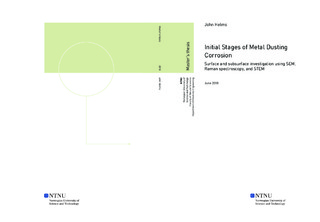| dc.description.abstract | Metal dusting (MD) is a corrosion phenomenon that often occurs in industrial processes involving syngas. Carbon deposited on vessel walls gradually causes disintegration of the bulk metal. Because MD is related to carbon deposition, conditions where MD can arise are often described using a thermodynamic parameter called carbon activity (a_c), which describes the likelihood of carbon deposition. MD can occur with a_c>1.
Inconel 601 and Incoloy 800 alloy wafers were treated in two steps. Wafers were first subjected to a 10% steam, 90% argon environment at 650◦C for 360 minutes. They were then exposed to a condition with very high a_c(> >1): a 10% carbon monoxide 90% argon, 540◦C environment for 20, 60, 120, 300, and 1200 minutes in an attempt to induce carbon deposition and metal dusting.
SEM indicated that 601 wafers experienced extensive development of carbon filaments
over the whole working wafer surface. Coverage was not as uniform on 800 wafers, but
evidence of carbon deposition was found on all wafers. The poor resistance of the 601 wafers to carbon deposition is likely due to the oxidation step not being aggressive enough to form a proper resistant oxide scale. Variation in carbon coverage on 800 wafers could arise from variation in the pre-polishing of the wafers, which was done by hand.
Analysis with Raman spectroscopy suggests that carbon on the surface of the 601 wafers has higher crystallinity than that on the 800 wafers, but there was no obvious trend with different duration of the metal dusting step.
An area on the 60 minute exposed 800 sample was selected for TEM study. A difference
in the amount of deposited carbon was identified on either side of a grain boundary. This difference was correlated with the development of a chromium-deficient layer and the oxide scale layer. A clearer, larger chromium-deficient layer and thicker oxide scale was associated with less carbon deposition on the surface. Carbon filaments were found to contain metal particles and separate them from the surface through growth. SAD indicated a grain orientation difference between the regions. Further Raman analysis was attempted on similar areas of the wafer. | |

